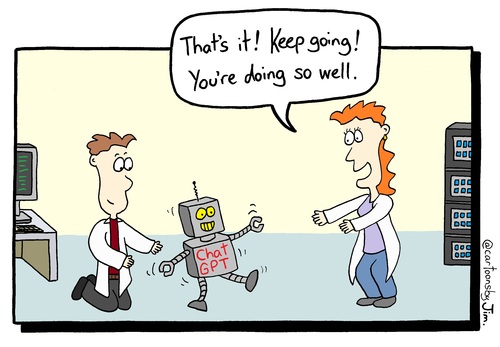Is Generative AI really coming for our jobs?
The latest Forrester Generative AI Jobs Impact Forecast for the US makes for really interesting reading.
Their summary is somewhat surprising in the face of other predictions and sensationalised headlines we have seen this year:
“Generative AI has captured the imaginations of leaders and employees alike, experiencing exponential growth in the workplace. This catalyzes questions about the future of jobs: It’s commonplace to hear pundits suggest that numerous job categories are doomed. We forecasted the future impacts of generative AI and found significant influence — that is, generative AI will reshape how many jobs operate and how work gets done. But job losses will be lower than many expect, and influence will far outweigh job cannibalization.”
They acknowledge the magic and mayhem GenAI is creating, some early signs of job augmentation and job losses at the same time as new jobs have been created. But their main message is - “Let’s Be Clear: Generative AI Is Coming After White Collar Jobs”
- Automation and AI overall will replace 4.9% of US jobs by 2030
- Generative AI will make up almost 30% of the jobs that will be lost to automation by 2030
- Generative AI will influence 4.5 times more jobs than it replaces
Most effected by these predictions will be Mid-salary, educated workers. Legal, office and administrative support, computing and mathematical occupations, healthcare, architecture and engineering, business and financial operations and management roles are all at the top of their list where the predicted impact will be the highest.
It’s not all doom and gloom, they go on to talk about reshaping the workforce to include GenerativeAI within your strategy and provide a framework for doing so. Leaving me thinking this isn’t new, but it has all happened so terribly terribly fast.
The future is here
I attended a talk Frances Valintine gave on where we are going with AI recently and she opened it with a slide that listed a heap of facts saying - imagine a moment in time where?:
- There as twice as many internet of things devices capturing our every action as there are people on the planet
- There is a place where driverless cars drive around the streets
- A country where fertility rates have dropped by 25% over the last 10 years
- Where island populations have been recreated in the Metaverse just to preserve their history before climate change makes their citizens climate refugees
- Or a country where there are 932 robots for every thousand humans
- Or where an AI generated songs become global hits within days of their release
Then she said - Welcome to 2023! (it took a minute for all of that to sink into my brain to be fair)
According to ComputerWorld job listings that are AI skills heavy have jumped 450% this year. “Roles gaining steam include prompt engineers, AI content creators, machine learning and deep learning engineers, data scientists, AI chatbot developers, and professionals with model tuning and AI model integration expertise,”
This same article tells us about the “Prompt Engineering Skills Test” designed to assess the capability of those filling this new popular role.
AI is not new
Contrary to what some believe AI was not invented 10 months ago when ChatGPT burst into our lives, it was augmented. Just to remind ourselves here is a brief history of AI written by GPT-4:
1950s:
- Alan Turing's "Computing Machinery and Intelligence": Introduces the Turing Test as a measure of machine intelligence.
- Birth of AI: The term "Artificial Intelligence" is coined at a Dartmouth College conference, marking the formal start of AI as a field of study.
1960s:
- ELIZA: Developed at MIT, one of the first computer programs that could mimic human conversation, albeit in a rudimentary way.
- Perceptrons: Early form of neural networks, introduced by Frank Rosenblatt, showing promise in pattern recognition.
1970s:
- Backpropagation: Key algorithm for training neural networks, leading to growth in machine learning.
- Expert Systems: Rise of rule-based systems designed to solve specific problems within certain domains.
1980s:
- Neural Network Renaissance: Rediscovery and enhancement of backpropagation sparks renewed interest in neural networks.
- Reinforcement Learning: Introduction of learning techniques where agents learn by interacting with environments.
1990s:
- Support Vector Machines: Popularized as a powerful method for classification and regression tasks.
- Hidden Markov Models: Used extensively in speech recognition systems.
2000s:
- Deep Learning Emergence: Neural networks with many layers (deep neural networks) demonstrate superior performance in various tasks.
- ImageNet Challenge: Large-scale competition in image classification, accelerating advancements in computer vision with deep learning.
2010s:
- AlphaGo: DeepMind's AI beats world champion in the game of Go, showcasing the power of deep reinforcement learning.
- Transformer Architecture: Introduced in the paper "Attention is All You Need," leading to major breakthroughs in natural language processing.
- BERT: A transformer-based model that sets new standards in NLP tasks, emphasizing the importance of context in language.
- IBM Watson: IBM's AI system gains worldwide attention by winning Jeopardy! against human champions, showcasing the potential of AI in processing vast amounts of information quickly.
Late 2010s - Present:
- Generative Adversarial Networks (GANs): A new class of AI algorithms used in unsupervised machine learning, instrumental in generating synthetic data.
- GPT (Generative Pre-trained Transformer): OpenAI introduces large language models, culminating in GPT-3, showcasing the potential of generative AI.
What can we all do
Invest in learning this new technology, how can GenAI help the organisation you work for improve their operations? How can you embrace this technology into your role and improve your own productivity? Now is the time for continuous learning to come into play, we all need to pivot slightly and in a positive framing.

